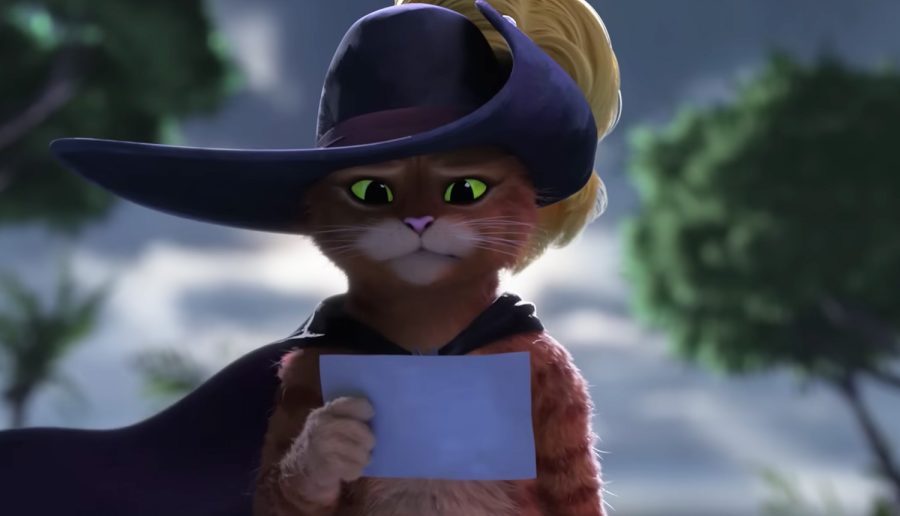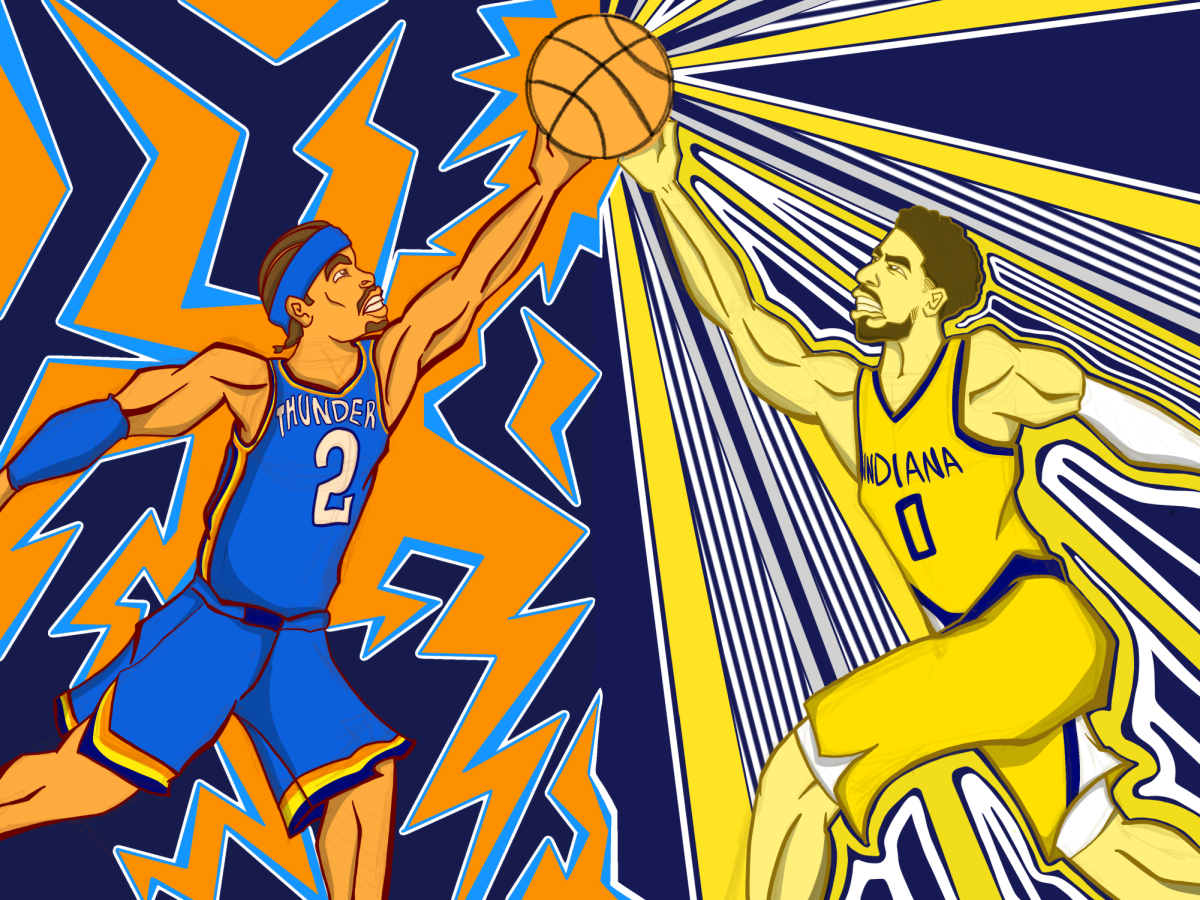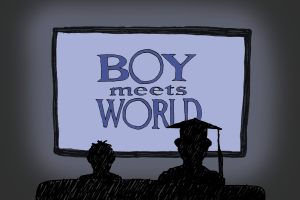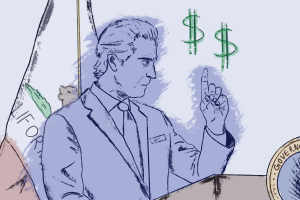Essay: Representation of Anxiety in “Puss in Boots: The Last Wish”
Feb 20, 2023
Over the last decade, animated movies have pushed for better representation. A wider breadth of cultures, ethnicities, and sexualities have become commonplace in animated movies. However, mental health remains rarely discussed, and often, it’s not well depicted. However, “Puss in Boots: The Last Wish” pushes for something I have not seen in animated movies — representation of anxiety.
“Puss in Boots: The Last Wish” follows Puss in Boots’ (Antonio Banderas) attempt to regain his nine lives, after he carelessly lived through eight of them. His only chance to regain those lives is to find the Wishing Star, which will grant one wish to anyone who finds it. Despite multiple adversaries fighting for the Wishing Star, Puss remains confident about the situation. But he is terrified of one thing, and that is Death.
Death is represented by a wolf (Wagner Moura). When Puss meets him at a bar, Puss is cocky. He has lived his life recklessly, much to Death’s annoyance. When Puss and Death battle for the first time, Death is exceptionally skilled in fighting, drawing blood from Puss. For him, Death represents the personification of Puss’ fear, which is not only death itself since he has died before, but the loss of his lifestyle, one that is filled with adventure and unpredictable events. A lifestyle that he has thrived on for all of his existence.
Once Puss realizes he has been injured, his fearlessness and overconfidence completely dissipate. His eyes dilate, his breathing becomes labored, and the hair on his body rises. In the background, we hear the sound of Puss’ racing heartbeat, further signifying his panic. It is evident that Puss fears Death, both literally and figuratively. This fear impairs him from doing the one thing he prides himself on being: a fearless hero. For the first time since we were introduced to the character in 2004, we see the character run away from a challenge. Even when Puss sees Death after their initial meeting, catching sight of the wolf causes Puss to speed off cowardly.
Puss’ fear of Death causes him to hide in the house of Mama Luna (Da-Vine Joy Rudolph), a crazy cat lady. Puss allows his fear to stop him from doing what he loves, and from there, he grows depressed. He does not care to interact with the other cats; he simply eats, drinks, uses the litter, and sleeps his days away. I like this point in the plot because it shows how anxiety can trigger other mental disorders. Since Puss does not know how to cope with his fear, he develops other obstacles which manifest from his anxiety, which is a reality for many people who have untreated mental illnesses.
The third interaction between Puss and Death is the one that I find the most important. While in the Dark Forest, Puss gets caught in a cross-combat between Jack Horner, Goldilocks, and her family. During the fight, Puss encounters Death once again. Despite the ringing in his ear from combat, the whistle of Death’s arrival is just as piercing as before. Though Puss wants to grab the map to The Wishing Star, he is frozen in fear, and the audience hears the faint sound of his speeding heartbeat. When experiencing anxiety, one’s body enters flight or fight mode, which is apparent in Puss’ reaction to Death’s appearance.
When Puss turns his head to look at Death, the screen for the audience starts to blur around the edges. The longer Puss stares at Death, the faster we hear his heart race. Eventually, as Puss runs away frantically into the nearby woods, he has hallucinations of Death despite only looking at trees and rocks in the forest. Once Perrito finds Puss, he is holding onto his chest, trying to catch his breath. The audience can still hear Puss’ heartbeat in the back, and Perrito tries to talk to him. Then, the audience is able to see from Puss’s point of view, where his vision is still blurry, and his hearing is still muffled from his high-stress level. It is not until Perrito lays his head down on him that Puss finally calms down. For the first time ever, Puss finally confesses to someone else that he is afraid. To which Perrito replies with a simple but essential reminder, “It’s okay to be afraid.” Puss starts to be open about his struggles with fear, despite the whole legend depicting him as the opposite.
He tells Perrito about his falling out with Kitty, which was a result of him leaving her at the altar. From this, the audience can piece together that Puss has run away in the past. Maybe Puss did not realize it at the time, but anxiety might have been something he has always dealt with, but repressed due to his image. It is evident that Puss loves Kitty, but fears the commitment of marriage will slow him down. Puss’ fear is not being married or Death itself, but is actually his life turning stagnant. Puss’ whole identity revolves around his wild life, and with that at stake, Puss does not know who he is.
What I find impressive about this film is its attention to detail regarding its representation of anxiety. It is not just “feeling nervous” but is marked by actual signs and symptoms. Some can be physically seen and heard, while others are dealt with in silence. Panic attacks look different for everyone, but there are a set of signs that are common, such as the ones depicted in this film.
What I like about “Puss in Boots: The Last Wish” is that it uses recurring cues to show when Puss is feeling anxious, such as his hair rising. But what I find incredibly well done is incorporating elements that Puss struggles with alone into the audience’s perspective. For instance, when Puss has a panic attack, his vision starts to blur, so the screen for the audience blurs too. Additionally, when the scene shifts to Puss’ point of view when Perrito is trying to get him to calm down, it is a really nice moment to see the entirety of what Puss is experiencing, without the whole panic attack being from his perspective. It also educates the audience on what having a panic attack can feel like without blatantly stating what Puss is struggling with. It is easy for children who are watching this movie to know that Puss is struggling with some, but does not plainly state so to the audience.
In the final battle between Puss and Death, Puss learns to overcome his fear of him by learning to accept what he can’t change. He looks back on his life and realizes he is surrounded by people he cares about, like Kitty and Perrito. He recognizes that he does not have to go through life alone and can learn to be vulnerable with others about his struggles. Because of this revelation, he finally gains the courage to fight Death back. At the end of their battle, Puss looks Death straight in the eye, showing Death that Puss is a changed kitty. From there, Puss’ struggle with Death, and his fear of him fades.
Tackling taboo subjects in a film can be difficult, especially when the target audience is kids. However, “Puss in Boots: The Last Wish” flawlessly tackles the issue of anxiety in an easily digestible way that everyone, including kids, can understand and gain something from. Struggling with mental health issues of any kind is hard enough, but “Puss in Boots: The Last Wish” tells its audience, “hey, it’s hard, but you don’t have to go through it alone,” and that’s a message that everyone needs to hear, no matter how old they are.
Image courtesy of Plugged In
















EllaThomas • Mar 19, 2023 at 9:40 pm
waoo this is a good movie and it’s really captivating I’ve watched it many times on netflix I admire that cat it’s a brave cat that dares to overcome fear to overcome a worthy wolf If you haven’t seen it yet, download here to see the movies worth watching
EllaThomas • Mar 19, 2023 at 9:37 pm
289 / 5.000
Kết quả dịch
Kết quả bản dịch
waoo this is a good movie and it’s really captivating I’ve watched it many times on netflix I admire that cat it’s a brave cat that dares to overcome fear to overcome a worthy wolf If you haven’t seen it yet, download here to see the movies worth watching